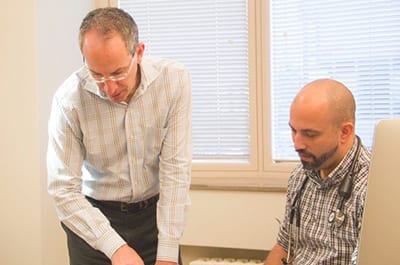You might have been thinking about it for a while now. You might be motivated by the recently published statement from the American Heart Association (backed up by multiple studies) about how having a dog might reduce your risk of cardiovascular disease and improve your health. Whatever the reason, you want to share time and maybe even a home with a dog, and that's great!
A few things to consider (or at least remind yourself about):
1. What kind of dog?
 Have goals, but be realistic, and think about what kind of life you currently lead.
Have goals, but be realistic, and think about what kind of life you currently lead.
- How much you are at home? Can a dog come to work with you or will you have to arrange for care during the hours that you are not there. There are doggy day-cares, and dog walkers who can come to your home.
- How big is your place? If you live in an apartment that is slightly larger than your own body's square feet, you may want to reconsider the idea of a Great Dane or other giant breed dog, since that dog and its bag of food alone will leave no additional room for you.
- Do you have a yard (and if so, is it enclosed)? At 3am, do you just need to open the back door and stand there, or will you also have to get up, get dressed and go outside with the dog whose bladder is calling?
- What is the climate in your area? Brachycephalic breeds such as Pugs are predisposed to trouble with overheating, so desert living without air conditioning is asking for trouble. Whippets without an appropriate wardrobe of down jackets will get very cold in Arctic climes.
- What activities might you want to share with a dog? If you are going to run more than 5 miles a day, a Chihuahua may not be the right choice; try something with slightly longer legs. If you are going to swim or enjoy other water activities, be aware that English Bulldogs will sink like a stone. If they are going to accompany you, they will need to wear a personal flotation device (PFD).
- Are there other people in the home (e.g. children, elderly)? Be aware that to a dog, a young child can easily be mistaken for a big squeaky dog toy, as they are dressed in bright colors, make high-pitched sounds and are often already smeared with delicious jam and peanut butter. In addition, children will have to be taught how to interact with a dog. Seniors often have fragile skin that will bruise or even tear from well-meaning but eager paws or nails that might scrape against them.
- Do you have allergies? Some dogs (e.g. Dalmatian or Jack Russell Terrier) will definitely shed, and their dander is more likely to exacerbate allergies. But dogs that have ‘Poodle type' hair (e.g. Poodle, Bichon Frisee, Portugese Water Dog) are less allergy-provoking.
- What is your current physical status? As sweet and gentle as a Golden Retriever will likely be, 80 pounds of enthusiasm on the end of a leash will pull you over every time, or at least strain your joints with the effort to hang on. The same untrained energy from a 7-pound Maltese might be easier to handle.
Do some homework ahead of time on certain breed characteristics and traits (N.B. these are general breed characteristics, and not absolutes; like us, they are all unique individuals).
There are some breeds that are meant for a lot of physical activity as often as possible (e.g. Labrador Retriever, German Shorthair Pointer) and some that are more low key and happy to take a more leisurely paced stroll and then relax doing more sedentary tasks (e.g Cavalier King Charles Spaniel).
Some breeds require a lot of mental stimulation as well as physical exercise (e.g. Border Collie, Jack Russell Terrier). Other breeds require a lot more upkeep and assistance with grooming (e.g. Poodles) and basic hygiene (e.g. Brachycephalic breeds).
2. Shelter or Breeder?
There are many shelters and rescue organizations. Most of them have websites where you can view photos and read descriptions. There are puppies, adults and senior pets all available and in need of homes. Shelters will often end up with many purebred dogs if hybrid vigor is not your thing. Petfinder.com is a great online resource that brings you access to just about anything you are looking for.
If you still aren't finding what you are looking for at the shelter, or are simply set on a breed that you want, don't forget to check breed-specific rescue organizations. There usually is one for most any breed you fancy. Often you will find dogs who have been loved very much, but whose owner has had to move (often overseas), has become ill, or has had a major lifestyle change that didn't agree with the dog, such as having a new baby. If you do go with a breeder check to be sure they are actually the breeder and not a broker, since many brokers advertise themselves as breeders but are just flying in the purebred puppies from what might be a disreputable ‘puppy mill.' American Kennel Club (AKC) is a valuable resource for breed information. But AKC certification just means that the dog is registered with them and therefore recognized as that particular breed. It does NOT reflect on the health or quality of the bloodline or breeding that was involved.
All dogs will require a time and care commitment from you, but puppies will need extra amounts of your time for basic training (inside and outside), multiple veterinary visits up through about 7 months of age (for routine vaccine series, spay/neuter, etc.) and socialization skills. You or your representative will have to be accountable for these things, as it is your responsibility to produce a good canine citizen.
Whether adult or puppy, don't forget about some form of insurance. The money has nothing to do with how much you love your dog, but these days even routine care or non-emergent things will add up quickly. The last thing you want is for finances to be the only thing guiding your decision-making in a medical situation. There is actual pet insurance you can get, or you can set aside an ‘amount' (I often recommend about $1000) to be used if needed.
4. Borrow a dog or own a dog?
If your current schedule isn't the right fit or some other legitimate reason prevents you from bringing a dog into your home/family to live right now, there are still many options open to you.
- You can arrange to ‘borrow' or take a friend/neighbor's dog for a walk on a scheduled daily or weekly basis.
- You can volunteer at a local shelter or rescue facility to spend time with or walk dogs on a scheduled daily or weekly basis. Visit the website of most organizations and there is usually a link for volunteer opportunities.
- You can foster or foster to adopt. If you think that you want to bring a dog home, but you are nervous that it won't be the right fit or are not sure that you can fully commit long-term to a dog, consider fostering or fostering to adopt. Most shelters and rescue organizations offer these as options (they need help with the overcrowding of the number of dogs in the shelter facility and they want dogs in homes that are the right fit, so that it will end up being permanent resulting in happy dogs and humans).
Conclusion
Getting a dog is a big financial, time and emotional commitment. It is worth every penny, moment, tear and smile. Just be honest, realistic and as prepared as you can before venturing forth. That way you are most likely to have an extremely successful and rewarding experience all around.
And if the end result for you is the resolution of your hypertension, or the ability to see your own feet again, that will be one more reason to smile back at your adoring new quadruped friend.
Laurie Pearlstein DVM









 with a reduction in heart disease risk factors and increased survival among patients.
with a reduction in heart disease risk factors and increased survival among patients.







 Two-thirds of patients will develop ocular involvement that may progress to blindness. Patients may develop arthritis, vasculitis, intestinal manifestations, or neurologic manifestations.
Two-thirds of patients will develop ocular involvement that may progress to blindness. Patients may develop arthritis, vasculitis, intestinal manifestations, or neurologic manifestations.




![By Hannes Grobe (Own work) [CC-BY-3.0 (http://creativecommons.org/licenses/by/3.0)], via Wikimedia Commons Broth](https://upload.wikimedia.org/wikipedia/commons/thumb/6/6f/Broth_hg.jpg/512px-Broth_hg.jpg)

